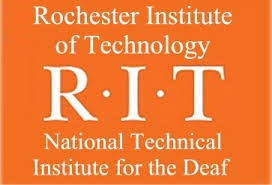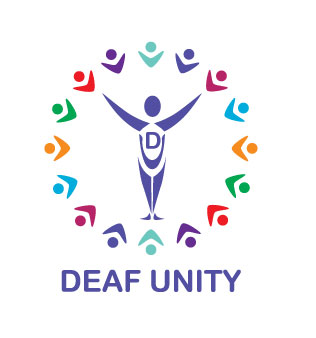This article was originally published on our CEO’s dedicated WCMT-research blog but we thought it was great and wanted to share it with you: http://duintheusa.wordpress.com/2013/09/26/du-visits-ritntid/
What a day! Thanks to the wonderful Erin Kane of the NTID, David and I had a packed day yesterday when we visited the Rochester Institute of Technology and the National Institute of Technology for the Deaf. Let me tell you a little about it!

RIT is an extremely well respected technical institute and is world renowned in its field. We were told that it is placed 34th in the United States for universities (think how many universities there are in America – wow!) and is the Rochester equivalent of the more famous MIT. RIT has nine colleges that make up its campus, one of which specializes in educating deaf and hard of hearing students in the technical field: NTID. Many of these students go on to enter the mainstream campus of RIT, or achieve specialized jobs in the technical environment.
The campus to this place is massive – it is more like a city. There are around 25,000 bodies on campus and the geographical footprint is just awesome. NTID itself serves around 1,300 students, in a variety of disciplines, so is around the same size as its more liberal-focused and well-known cousin, Gallaudet. Approximately 74% of their intake are from mainstream schools, with 27% having a cochlear implant and 50% using a hearing aid. Almost half of its intake is from the East coast, with New York State being the main focus.
Prior to the visit, I was just overwhelmed by the visit we made to Gallaudet and was so impressed by the social and personal advantages of being in such an environment: deaf friendly in its curriculum, teaching and even its architecture, with full immersion in sign language and Deaf culture. I was not sure how I felt about mainstreaming after this visit and felt a little sad that I had not been to such a university. Now having made the visit to RIT and NTID, I am split again in my feelings and can see the advantages of both establishments. I guess that is how I would sum RIT and NTID up – best of both worlds.
RIT is a massive university that educates its students to an extremely high level. Its students are sought out across the USA and even globally. The rigor of the courses is not to be laughed at and students fight to be there and achieve. One of my friends with whom I have been in contact with for a number of years is an inspirational young man called Bakar Ali (We featured Bakar back in March – to read his story, click on this link: https://deafunity.org/article-interview/bakar-ali-deaf-in-somalia/ ). His dedication and effort in his studies humbled me and spoke volumes of how highly he prized his place at this university.
For Deaf students, they also have all the benefits of Gallaudet – a full signing environment, courses where they can be taught directly in sign language and a massive deaf-peer and role-model presence to help inspire and drive them. Once again, it was a delight to order my coffee in sign language, ask the food server directly in sign language what the vegetables were for lunch and to have deaf aware staff to show me the price on the till instead of mumbling it to themselves. David and I also were able to sit in on a second-year class being taught – Qualitative Instrumental Analysis – by a deaf professor to a class of about 11 or so deaf students. Seeing them all engaged and signing, yet discussing this really intricate subject was just amazing.
RIT and NTID are also very proud of the fact that they are not just a bunch of engineers and accountants! Dr. Linda Bryant, the Associate Dean for Student and Academic Studies spent a long time describing to us how their extra-curricular activities are wide ranging and educational at the same time. The NTID have their own student government and a host of associations and clubs. Yet, they do not live in their own bubble. Our lovely tour guide was the dramatic Lauren Aggen who had just joined a sorority – a hearing girls house that is equally mixed with deaf and hearing. As she took us around, she was greeted and hugged by her new ‘sisters’ who are all able to sign to some extent. We were also informed that the President of the student government for the whole of RIT was Deaf and had been elected by the student body for two terms!
The emphasis of RIT was definitely more scholastic than other places we have seen, as they have a reputation to uphold. That seems to drive the hearing and deaf students to master English and their subjects, utilizing all the support and networks available to them, all with their eyes on gaining an RIT degree. Many of the deaf students are enrolled in mainstream classes and have the usual support of interpreters and notetakers in class. Here, though, there might be six deaf students in a class of twenty, as opposed to many of the classes that the deaf in the UK find themselves in – usually the only deaf student within the whole year’s cohort. NTID also provide a learning centre where students can get extra help with Maths and English (interestingly, not ASL) to make sure that their core subjects are up to par. Their transitional services are excellent – both for new students and those preparing to leave. We had some very interesting conversations with the two Johns from the Admissions and Employment departments.
Our last meeting of the day was with Dr. Raja Kushalnagar, who was an inspiration. An Indian-born Deaf man, he holds several degrees and is involved currently in researching a new way to make the learning environment more conducive to deaf learners utilizing an interpreter in the classroom. I really hope to be able to write a separate feature at some point on his research, but in layman’s terms, he is working on a system to lessen the amount a deaf student misses when in class. Over 90% of the time spent in class, the deaf student is looking at the interpreter. The other 10% percent is spent glancing at the teacher, the notes he is taking, the board and his fingernails. Compare this to a hearing student who basically never looks away from the board as he is able to listen to the teacher’s explanation at the same time, even when checking his fingernails, Facebook or his reflection. Dr Raj is working on an amazing piece of technical support that allows a student to have all necessary information presented on a laptop screen and interact with it to maximize capture of the information. I am not sure how much I am allowed to say, so I shall stop there, but it sounds revolutionary.
I guess that sums it up – RIT and NTID work together with success and excellence as its goal. Along with this, the students are given a holistic experience that cultivates driven and confident young people – deaf or hearing – that are ready to emerge into the workforce.
Thank you to all those that we met and took time from their incredible schedules to discuss my research.


Many thanks for the really informative blog post! Gallaudet, RIT and NTID look like excellent institutions and there’s a lot that other universities can learn from their set-up.
I was also very interested to hear about Dr. Raja Kushalnagar’s work – while we didn’t have access to any programmer, we ran a project at the University of Leeds which you and Dr. Kushalnagar may find interesting: two lecturers in the Centre for Translation Studies teamed up with our University’s Equality Service to adapt an existing online conferencing system (Adobe Acrobat Connect Pro) to the needs of our hard-of-hearing, but also local and overseas students. Following the success of our initial project (detailed in Session 5 of the Access Conference we organised last year http://www.sddu.leeds.ac.uk/sddu-usef-dragos-ciobanu.html; btw, as you will see, we also welcomed Bee Communications and Ai-Media at our event), we now use live captioning and interactive lecture recording in one core module with approximately 100 students, and interactive lecture recording in other modules which are not attended by any hard-of-hearing students. The really good news is that the system is very easy to set up and our students are very appreciative of the resources, regardless of whether they have a hearing impairment or not.
Together with my colleagues in the Equality Service, I’d be very happy to expand on anything you may need more info on. In the meantime, a very Happy New Year to you and all your colleagues!
Dragos
Dr. Dragoș Ciobanu